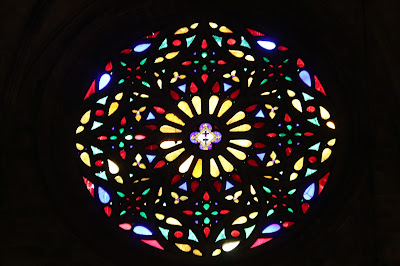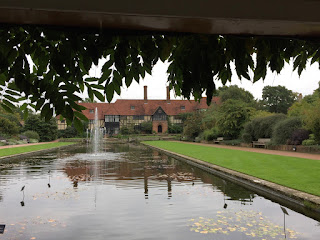The continent of Europe lies in the temperate climate zone, which means around the end of October, it is difficult to find a warm, sunny place within 2 hours of flying time from London. The trees were bringing out their golden wardrobe, the sun was beginning to doze off around 4pm and autumn was making its presence felt. Winter with its short, cold rainy days and long, colder nights was around the corner and a week in the sun was what we needed. A group of islands to the east of Spain caught our attention. While living in California, I had come across brightly colored Majorca ceramics and that was all I knew about Majorca, Spain. The weather forecast predicted average highs in the high 60s (Fahrenheit) and pictures of the idyllic blue green waters of the Mediterranean sealed the deal. We were going to Mallorca!
Mallorca is the largest of the Baleariac islands in the Mediterranean Sea. It is a popular tourist destination with a modern international airport at its capital city, Palma de Mallorca. Going to a country where English is not the official language always excites me as it is an immersive experience in a language like no other. Over the years, I have tried, unsuccessfully, to learn Spanish but have only managed to know enough to read my way through signs, instructions and brochures. It was therefore very surprising see that at the airport, the signs were in English, German(!), Spanish and more Spanish, though not exactly. It was only later, at the hotel when I asked the receptionist about it, that I found out that Germans make up the majority of tourists in Mallorca and Spanish is not the official language. It is Catalan, specifically a dialect known as Mallorquin which sounds like Spanish but is not quite Spanish.
Palma is the hub of tourist activity in Mallorca. It is a big city like any other with impressive infrastructure and facilities. But we were in Mallorca to to get away from it all. So we picked up the rental car and headed for Cala D'or, a sleepy village on the island's east coast.
Highway MA-19 winds through the central plain or Es Pla as it is locally known. It is a scraggly almost arid landscape; not what one expects on an island. There was no verdant shrubbery, palm trees frolicking in the wind or the salty smell of sea air. Instead, gnarled, knobbly and stout olive trees stood betweens acres of reluctant grape vines in front of rocky hills jutting out of the ground as far as the eye could see, under a bright clear blue sky. As we were got closer to the coast, we drove through sleepy villages-it was siesta time after all- with modest white-washed houses with green shutters, red tiles and delightful names like Felantx and Santanyi. Here the landscape was agricultural with narrow roads flanked by large orange and lemon orchards.
Cala d'or was exactly I was hoping it would be. The town center is a maze of cobblestone streets with stores and cafes serving olives, iberico and serrano ham, pa amb oli with Mallorcan cheese and fresh seafood and padron peppers! We settled on paella for dinner and called it a night.
You don't need much when the water is warm, you are a short drive away from a fine sandy beach and the beach is not over run by people. To the sound of crashing waves and giggling children, add the call of the local fruit vendor selling pineapples and coconuts to the amused foreigners and the smell of fried sardines wafting from nearby cafes - it is a picture perfect postcard! However, there is always land to be explored and on one of the days, we took out the car and the maps and headed out to explore the rest of the island.
Driving west, we left Palma behind and climbed up and down the rugged mountain range of Serra de Tramuntana. The entire mountain range is designated as a UNESCO World Heritage site, owing to its importance in the cultural and agricultural life of its settlers. Our first stop was Port D'Andratx. Lore has it that this natural port was raided frequently by Turkish pirates and to preserve their town, the locals moved it inland to Andratx. Whether at the water or inland, this lovely town is surrounded by fortifications and boasts an impoing Gothic parish church.


Driving further along the jagged northwestern coast of the island, the majestic blue green waters of the Mediterranean lie at the bottom of rugged formidable cliffs shaded by pine trees. This is not an easy landscape to conquer which makes it quite impressive to see fields of grapes, almonds and citrus here. The mountainous landscape is latticed with a network of dense dry stone walls known as paret seca made of irregular stones, diving the land into parcels. It is not uncommon to see these walls creep up along the cliff faces and carve out terraces on which the locals farm and tend to livestock like their ancestors used to. The Moors who came to this island in 902 AD are thought to have brought this knowledge with them from their native arid Africa. The technique is still in use here leading to agriculture being a vital part of the economy alongside tourism. This is unspoilt Mallorca at its best. Delightful towns of Estellencs and Banyalbufar and further north, Valdemossa beg you to stop your wanderings and take in the sprawling vistas, inhale the fresh air and leave your worries behind.
A couple more days of glorious sloth on the beach ensued and the day before we had to head back to reality, we decided to venture out into Palma. After walking the narrow lanes of the old town, we reached the star attraction, the Cathedral of Palma.
The cathedral of Santa Maria de Palma or La Seu as it is commonly known is a Gothic Roman Catholic cathedral towering over the bay of Palma. Work on this cathedral began in 1229 AD under King James I of Aragon and was finished in 1601. However, work continued into the present century when the famed Catalan, Antonio Gaudi took up the work of restoring this behemoth of sandstone held together by arches and flying buttresses. The cathedral is adorned with Gothic style elements like gargoyles, railings and spires and the preference of horizontal lines over vertical. It is believed that 15 generations of architects worked on this cathedral, to make it the masterpiece it currently is.
Stained glass windows occupy the place of pride in any chapel, church, or cathedral. However, the Rose window on the eastern wall of this cathedral, 12 m across and studded with 1236 pieces of stained glass, is the largest and most majestic sight to behold.
Our time at Mallorca had come to an end. One week is not enough time to appreciate this island's people, culture and Nature. We bid adeu (goodbye in Mallorquin) to our Mediterranean pardise that has inspired the likes of Sands, Borges and Agatha Christie and promised we will be back, soon.
















































